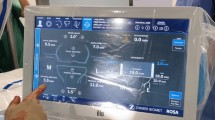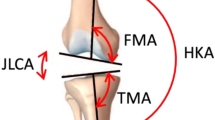Abstract
Purpose
Kinematic alignment technique for TKA aims to restore the individual knee anatomy and ligament tension, to restore native knee kinematics. The aim of this study was to compare parameters of kinematics during gait (knee flexion–extension, adduction–abduction, internal–external tibial rotation and walking speed) of TKA patients operated by either kinematic alignment or mechanical alignment technique with a group of healthy controls. The hypothesis was that the kinematic parameters of kinematically aligned TKAs would more closely resemble that of healthy controls than mechanically aligned TKAs.
Methods
This was a retrospective case–control study. Eighteen kinematically aligned TKAs were matched by gender, age, operating surgeon and prosthesis to 18 mechanically aligned TKAs. Post-operative 3D knee kinematics analysis, performed with an optoelectronic knee assessment device (KneeKG®), was compared between mechanical alignment TKA patients, kinematic alignment TKA patients and healthy controls. Radiographic measures and clinical scores were also compared between the two TKA groups.
Results
The kinematic alignment group showed no significant knee kinematic differences compared to healthy knees in sagittal plane range of motion, maximum flexion, abduction–adduction curves or knee external tibial rotation. Conversely, the mechanical alignment group displayed several significant knee kinematic differences to the healthy group: less sagittal plane range of motion (49.1° vs. 54.0°, p = 0.020), decreased maximum flexion (52.3° vs. 57.5°, p = 0.002), increased adduction angle (2.0–7.5° vs. − 2.8–3.0°, p < 0.05), and increased external tibial rotation (by a mean of 2.3 ± 0.7°, p < 0.001). The post-operative KOOS score was significantly higher in the kinematic alignment group compared to the mechanical alignment group (74.2 vs. 60.7, p = 0.034).
Conclusions
The knee kinematics of patients with kinematically aligned TKAs more closely resembled that of normal healthy controls than that of patients with mechanically aligned TKAs. This may be the result of a better restoration of the individual’s knee anatomy and ligament tension. A return to normal gait parameters post-TKA will lead to improved clinical outcomes and greater patient satisfaction.
Level of evidence
III.

Similar content being viewed by others
References
Almaawi AM, Hutt JRB, Masse V, Lavigne M, Vendittoli P-A (2017) The impact of mechanical and restricted kinematic alignment on knee anatomy in total knee arthroplasty. J Arthroplasty 32:2133–2140
Andriacchi TP, Stanwyck TS, Galante JO (1986) Knee biomechanics and total knee replacement. J Arthroplasty 1:211–219
Arnold JB, Mackintosh S, Olds TS, Jones S, Thewlis D (2015) Improvements in knee biomechanics during walking are associated with increased physical activity after total knee arthroplasty. J Orthop Res 33:1818–1825
Bourne RB, Chesworth BM, Davis AM, Mahomed NN, Charron KDJ (2010) Patient satisfaction after total knee arthroplasty: who is satisfied and who is not? Clin Orthop Relat Res 468:57–63
Butler RJ, Barrios JA, Royer T, Davis IS (2011) Frontal-plane gait mechanics in people with medial knee osteoarthritis are different from those in people with lateral knee osteoarthritis. Phys Ther 91:1235–1243
Calliess T, Bauer K, Stukenborg-Colsman C, Windhagen H, Budde S, Ettinger M (2017) PSI kinematic versus non-PSI mechanical alignment in total knee arthroplasty: a prospective, randomized study. Knee Surg Sports Traumatol Arthrosc 25:1743–1748
Clément J, de Guise JA, Fuentes A, Hagemeister N (2018) Comparison of soft tissue artifact and its effects on knee kinematics between non-obese and obese subjects performing a squatting activity recorded using an exoskeleton. Gait Posture 91:197–203
Clément J, Toliopoulos P, Hagemeister N, Desmeules F, Fuentes A, Vendittoli P-A (2018) Healthy 3D knee kinematics during gait: differences between women and men, and correlation with X-ray alignment. Gait Posture 64:198–204
Collins M, Lavigne M, Girard J, Vendittoli PA (2012) Joint perception after hip or knee replacement surgery. Orthop Traumatol Surg Res 98:275–280
Courtney PM, Lee GC (2017) Early outcomes of kinematic alignment in primary total knee arthroplasty: a meta-analysis of the literature. J Arthroplasty 32:2028–2032
Dossett HG, Estrada NA, Swartz GJ, LeFevre GW, Kwasman BG (2014) A randomised controlled trial of kinematically and mechanically aligned total knee replacements: two-year clinical results. Bone Jt J 96-B:907–913
Gu Y, Roth JD, Howell SM, Hull ML (2014) How frequently do four methods for mechanically aligning a total knee arthroplasty cause collateral ligament imbalance and change alignment from normal in white patients? AAOS exhibit selection. J Bone Jt Surg Am 96:e101
Hagemeister N, Parent G, Van de Putte M, St-Onge N, Duval N, de Guise J (2005) A reproducible method for studying three-dimensional knee kinematics. J Biomech 38:1926–1931
Howell SM, Howell SJ, Hull ML (2010) Assessment of the radii of the medial and lateral femoral condyles in varus and valgus knees with osteoarthritis. J Bone Jt Surg Am 92:98–104
Hutt JRB, LeBlanc MA, Massé V, Lavigne M, Vendittoli PA (2016) Kinematic TKA using navigation: surgical technique and initial results. Orthop Traumatol Surg Res 102:99–104
Johnson TSLM, Yao JQ, Gilbertson LN (2001) The effect of displacement control input parameters on tibiofemoral prosthetic knee wear. Wear 250:222–226
Kirschberg J, Goralski S, Layher F, Sander K, Matziolis G (2018) Normalized gait analysis parameters are closely related to patient-reported outcome measures after total knee arthroplasty. Arch Orthop Trauma Surg 138:711–717
Labbe DR, Hagemeister N, Tremblay M, de Guise J (2008) Reliability of a method for analyzing three-dimensional knee kinematics during gait. Gait Posture 28:170–174
Lee YS, Howell SM, Won YY, Lee OS, Lee SH, Vahedi H et al (2017) Kinematic alignment is a possible alternative to mechanical alignment in total knee arthroplasty. Knee Surg Sports Traumatol Arthrosc. https://doi.org/10.1007/s00167-017-4558-y
Li G, Park SE, DeFrate LE, Schutzer ME, Ji L, Gill TJ et al (2005) The cartilage thickness distribution in the tibiofemoral joint and its correlation with cartilage-to-cartilage contact. Clin Biomech (Bristol Avon) 20:736–744
Li Y, Wang S, Wang Y, Yang M (2018) Does kinematic alignment improve short-term functional outcomes after total knee arthroplasty compared with mechanical alignment? A systematic review and meta-analysis. J Knee Surg 31:78–86
Lustig S, Magnussen RA, Cheze L, Neyret P (2012) The KneeKG system: a review of the literature. Knee Surg Sports Traumatol Arthrosc 20:633–638
Matsumoto T, Takayama K, Ishida K, Hayashi S, Hashimoto S, Kuroda R (2017) Radiological and clinical comparison of kinematically versus mechanically aligned total knee arthroplasty. Bone Jt J 99-B:640–646
McClelland JA, Webster KE, Feller JA (2007) Gait analysis of patients following total knee replacement: a systematic review. Knee 14:253–263
McNair PJ, Boocock MG, Dominick ND, Kelly RJ, Farrington BJ, Young SW (2017) A comparison of walking gait following mechanical and kinematic alignment in total knee joint replacement. J Arthroplasty. https://doi.org/10.1016/j.arth.2017.09.031
Nam D, Lin KM, Howell SM, Hull ML (2014) Femoral bone and cartilage wear is predictable at 0 degrees and 90 degrees in the osteoarthritic knee treated with total knee arthroplasty. Knee Surg Sports Traumatol Arthrosc 22:2975–2981
Nam D, Nunley RM, Barrack RL (2014) Patient dissatisfaction following total knee replacement: a growing concern? Bone Jt J 96-B:96–100
Niki Y, Nagura T, Nagai K, Kobayashi S, Harato K (2018) Kinematically aligned total knee arthroplasty reduces knee adduction moment more than mechanically aligned total knee arthroplasty. Knee Surg Sports Traumatol Arthrosc 26:1629–1635
Riviere C, Ollivier M, Girerd D, Argenson JN, Parratte S (2017) Does standing limb alignment after total knee arthroplasty predict dynamic alignment and knee loading during gait? Knee 24:627–633
Sati M, de Guise J, Larouche S, Drouin G (1996) Improving in vivo knee kinematic measurements: application to prosthetic ligament analysis. Knee 3:179–190
Takahashi T, Ansari J, Pandit HG (2018) Kinematically aligned total knee arthroplasty or mechanically aligned total knee arthroplasty. J Knee Surg. https://doi.org/10.1055/s-0038-1632378
Turcot K, Sagawa Y Jr, Fritschy D, Hoffmeyer P, Suva D, Armand S (2013) How gait and clinical outcomes contribute to patients’ satisfaction three months following a total knee arthroplasty. J Arthroplasty 28:1297–1300
Vendittoli PA, Blakeney W (2017) Redefining knee replacement. Orthop Traumatol Surg Res 103:977–979
Waterson HB, Clement ND, Eyres KS, Mandalia VI, Toms AD (2016) The early outcome of kinematic versus mechanical alignment in total knee arthroplasty: a prospective randomised control trial. Bone Jt J 98-B:1360–1368
Yoon JR, Han SB, Jee MK, Shin YS (2017) Comparison of kinematic and mechanical alignment techniques in primary total knee arthroplasty: a meta-analysis. Medicine (Baltimore) 96:e8157
Young SW, Walker ML, Bayan A, Briant-Evans T, Pavlou P, Farrington B (2017) The Chitranjan S. Ranawat Award: no difference in 2-year functional outcomes using kinematic versus mechanical alignment in TKA: a randomized controlled clinical trial. Clin Orthop Relat Res 475:9–20
Funding
Research funds were provided by Maisonneuve-Rosemont Hospital Fundation.
Author information
Authors and Affiliations
Corresponding author
Ethics declarations
Conflict of interest
None of the author have proprietary, financial, professional or other personal interest of any nature or kind of any product, service and/or company that could be construed as influencing the position presented in the manuscript.
Ethical approval
Ethical approval was obtained from the research and ethics committee (CIUSSS de l’Est-de-l’Île-de-Montréal, Project number 2011-462), and all patients gave informed consent.
Rights and permissions
About this article
Cite this article
Blakeney, W., Clément, J., Desmeules, F. et al. Kinematic alignment in total knee arthroplasty better reproduces normal gait than mechanical alignment. Knee Surg Sports Traumatol Arthrosc 27, 1410–1417 (2019). https://doi.org/10.1007/s00167-018-5174-1
Received:
Accepted:
Published:
Issue Date:
DOI: https://doi.org/10.1007/s00167-018-5174-1




